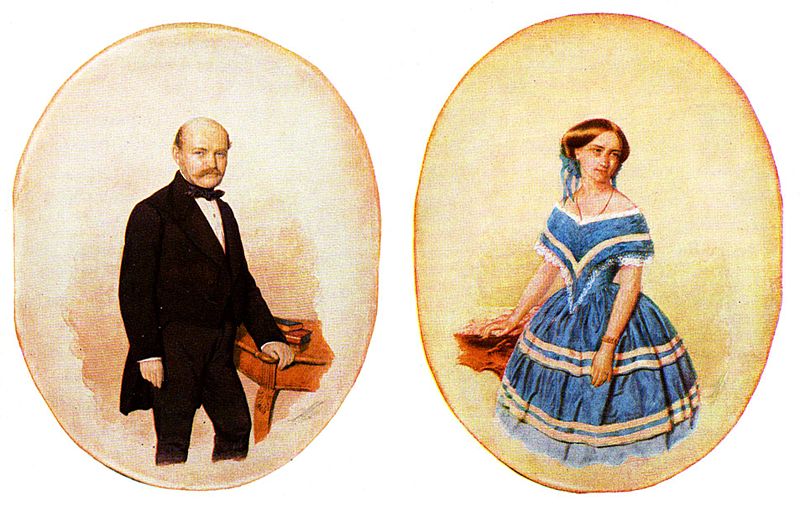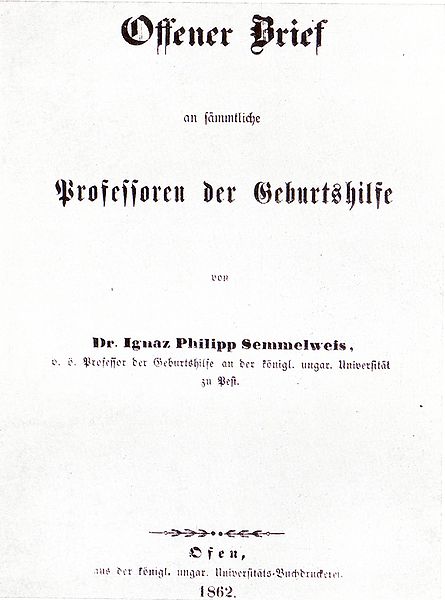<Back to Index>
- Physician Ignác Fülöp Semmelweis, 1818
- Architect Josep Lluís Sert i López, 1902
- King of Denmark, Norway and Sweden Christian II, 1481
PAGE SPONSOR
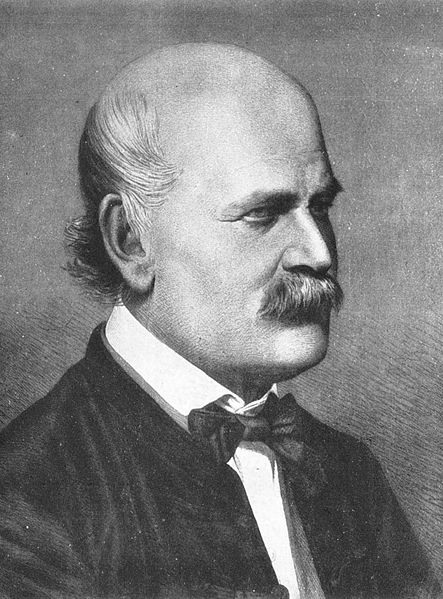
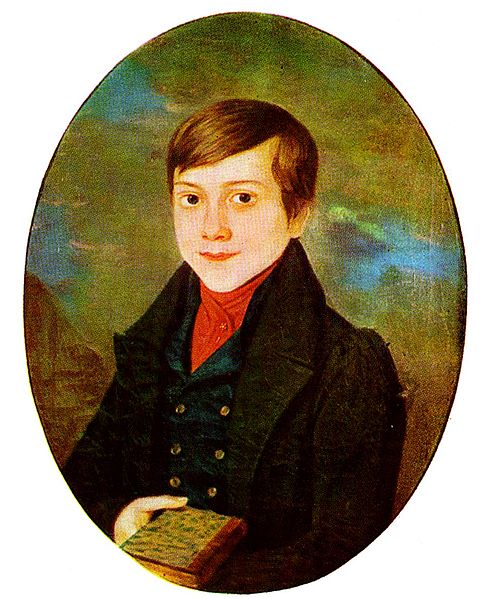
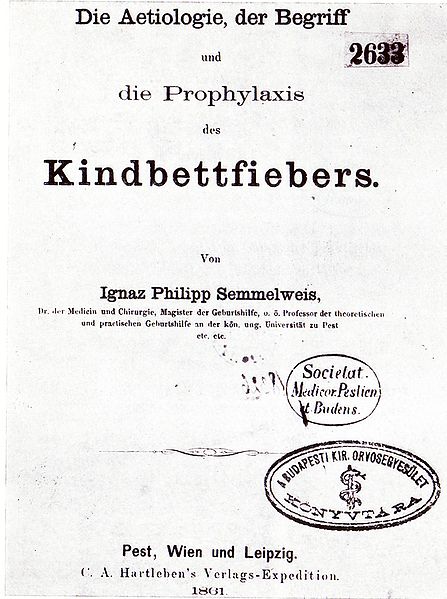
Ignaz Philipp Semmelweis (July 1, 1818 – August 13, 1865; in Hungarian Semmelweis Ignác Fülöp) was a Hungarian physician described as the "savior of mothers", who discovered by 1847 that the incidence of puerperal fever could be drastically cut by the use of hand disinfection (by means of hand washing with chlorinated lime solution) in obstetrical clinics. Puerperal fever (or childbed fever) was common in mid 19th century hospitals and often fatal, with mortality at 10% – 35%. Semmelweis postulated the theory of washing with "chlorinated lime solutions" in 1847 while working in Vienna General Hospital's First Obstetrical Clinic, where doctors' wards had three times the mortality of midwives' wards. He published a book of his findings in childbed fever in Etiology, Concept and Prophylaxis of Childbed Fever.
Despite various publications of results where hand washing reduced mortality to below 1%, Semmelweis's practice earned widespread acceptance only years after his death, when Louis Pasteur confirmed the germ theory. In 1865, a nervous breakdown (or possibly Alzheimer's) landed him in an asylum, where Semmelweis ironically died of septicemia, at age 47. Ignaz Semmelweis was born on July 1, 1818 in the Tabán, an area of Budapest, Hungary (then part of the Habsburg Empire). He was the fifth child out of ten of a prosperous grocer family of Josef and Teresia Müller Semmelweis. The family was German speaking. His father, Josef Semmelweis (1778 – 1846), was born in Eisenstadt (Hungarian Kismarton), then in Hungary. Josef achieved permission to set up shop in Buda in 1806 and, in the same year, opened a wholesale business with spices and general consumer goods named zum Weißen Elephanten (to the White Elephant) in Heindl-Haus in Tabán (today a museum). By 1810, he was a wealthy man when he married Teresia Müller, daughter of the famous vehicle builder Fülöp Müller. Semmelweis began studying law at the University of Vienna in
the autumn of 1837, but by the following year, for reasons that are no
longer known, he had switched to medicine. He was awarded his doctorate
degree in medicine in 1844. After failing to obtain an appointment in a
clinic for internal medicine, Semmelweis decided to specialize in
obstetrics. Some of his teachers included Carl von Rokitansky, Josef Skoda and Ferdinand von Hebra. Semmelweis was appointed assistant to Professor Klein in the First Obstetrical Clinic of the Vienna General Hospital on July 1, 1846. A comparable position today would be "chief resident." His
duties were to examine patients each morning in preparation for the
professor's rounds, supervise difficult deliveries, teach students of
obstetrics and be 'clerk' of records. Maternity institutions were set up all over Europe to address problems of infanticide of
"illegitimate" children. They were set up as gratis institutions and
offered to care for the infants, which made them attractive to
underprivileged women, including prostitutes. In return for the free
services, the women would subject themselves to the training of doctors
and midwives. There were two maternity clinics at the Viennese
hospital. The First Clinic had an average maternal mortality rate due to puerperal fever of about 10% (actual rates fluctuated wildly). The Second Clinic's rate
was considerably lower, averaging less than 4%. This fact was known
outside the hospital. The two clinics admitted on alternate days but
women begged to be admitted to the Second Clinic due to the bad
reputation of the First Clinic. Semmelweis described desperate women
begging on their knees not to be admitted to the First Clinic. Some women even preferred to give birth in the streets, pretending to have given sudden birth en route to the hospital (a practice known as street births),
which meant they would still qualify for the child care benefits
without having been admitted to the clinic. Semmelweis was puzzled that
puerperal fever was rare amongst women giving street births. "To me, it
appeared logical that patients who experienced street births would
become ill at least as frequently as those who delivered in the clinic.
[...] What protected those who delivered outside the clinic from these
destructive unknown endemic influences?" Semmelweis
was severely troubled and literally sickened that his First Clinic had
a much higher mortality rate due to puerperal fever than the Second
Clinic. It "made me so miserable that life seemed worthless". The
two clinics used almost the same techniques, and Semmelweis started a
meticulous process of eliminating all possible differences, including
even religious practices. The only major difference was the individuals
who worked there. The First Clinic was the teaching service for medical
students, while the Second Clinic had been selected in 1841 for the
instruction of midwives only. He
excluded "overcrowding" as a cause, since the Second Clinic was always
more crowded and yet the mortality was lower. He eliminated climate as
a cause because the climate was the same. The breakthrough occurred in
1847, following the death of his good friend Jakob Kolletschka, who had been accidentally poked with a student's scalpel while performing a postmortem examination. Kolletschka's own autopsy showed a pathology similar to that of the women who were dying from puerperal fever. Semmelweis immediately proposed a connection between cadaveric contamination and puerperal fever. He concluded that he and the medical students carried "cadaverous particles" on their hands from the autopsy room to the patients they examined in the First Obstetrical Clinic. This explained why the student midwives in the Second Clinic, who were not engaged in autopsies and had no contact with corpses, saw a much lower mortality rate. The germ theory of disease had
not yet been developed. Thus, Semmelweis concluded some unknown
"cadaverous material" caused childbed fever. He instituted a policy of
using a solution of chlorinated lime (modern calcium hypochlorite,
the compound used in today's common household chlorine bleach solution)
for washing hands between autopsy work and the examination of patients.
He did this because he found that this chlorinated solution worked best
to remove the putrid smell of infected autopsy tissue, and thus perhaps
destroying the causal "poisonous" or contaminating "cadaveric" agent
hypothetically being transmitted by this material. The
result was that the mortality rate dropped 90%, comparable to the
Second Clinic's. The mortality rate in April 1847 was 18.3%; after
handwashing was instituted in mid May, the rates in June were 2.2%,
July
1.2 %, August 1.9% and, for the first time since the introduction
of anatomical orientation, the death rate was zero in two months in the
year following this discovery. Semmelweis discovered that cases of puerperal fever, a form of septicaemia also known as childbed fever, could be cut drastically if doctors washed their hands in a chlorine solution before gynaecological examinations. While employed as assistant to the professor of the maternity clinic at the Vienna General Hospital in Austria in 1847, Semmelweis introduced hand washing with chlorinated lime solutions for
interns who had performed autopsies. This immediately reduced the
incidence of fatal puerperal fever from about 10 percent (range 5 – 30
percent) to about 1 – 2 percent. At the time, diseases were attributed to
many different and unrelated causes. Each case was considered unique,
just as a human person is unique. Semmelweis's hypothesis, that there
was only one cause, that all that mattered was cleanliness, was extreme
at the time, and was largely ignored, rejected or ridiculed. He was
dismissed from the hospital for political reasons and harassed by the
medical community in Vienna, being eventually forced to move to Pest. Semmelweis
was outraged by the indifference of the medical profession and began
writing open and increasingly angry letters to prominent European
obstetricians, at times denouncing them as irresponsible murderers. His
contemporaries, including his wife, believed he was losing his mind,
and in 1865 he was committed to an asylum. In an ironic twist of fate, he died there of septicaemia only 14 days later, possibly after being severely beaten by guards.
Semmelweis's practice earned widespread acceptance only years after his
death, when Louis Pasteur developed the germ theory of disease, offering a theoretical explanation for Semmelweis's findings. He is considered a pioneer of antiseptic procedures. Semmelweis's observations conflicted with the established scientific and medical opinions of the time. The theory of diseases was highly influenced by ideas of an imbalance of the basic "four humours" in the body, a theory known as dyscrasia, for which the main treatment was bloodlettings.
Medical texts at the time emphasized that each case of disease was
unique, the result of a personal imbalance, and the main difficulty of
the medical profession was to establish precisely each patient's unique
situation, case by case. The
findings from autopsies of deceased women also showed a confusing
multitude of various physical signs, which emphasised the belief that
puerperal fever was not one, but many different, yet unidentified,
diseases. Semmelweis's main finding — that all instances of puerperal
fever could be traced back to only one single cause: lack of
cleanliness — was simply unacceptable. His findings also ran against
the conventional wisdom that diseases spread in the form of "bad air",
also known as miasmas or
vaguely as "unfavourable atmospheric - cosmic - terrestrial influences".
Semmelweis's groundbreaking idea was contrary to all established
medical understanding. As
a result, his ideas were rejected by the medical community. Other more
subtle factors may also have played a role. Some doctors, for instance,
were offended at the suggestion that they should wash their hands; they
felt that their social status as gentlemen was inconsistent with the
idea that their hands could be unclean. Specifically,
Semmelweis's claims were thought to lack scientific basis, since he
could offer no acceptable explanation for his findings. Such a
scientific explanation was made possible only some decades later, when
the germ theory of disease was developed by Louis Pasteur, Joseph Lister, and others. During
1848, Semmelweis widened the scope of his washing protocol to include
all instruments coming in contact with patients in labor, and used
mortality rate time series to document his success in virtually eliminating puerperal fever from the hospital ward. Toward
the end of 1847, accounts of Semmelweis's work began to spread around
Europe. Semmelweis and his students wrote letters to the directors of
several prominent maternity clinics describing their recent
observations. Ferdinand von Hebra, the editor of a leading Austrian medical journal, announced Semmelweis's discovery in the December 1847 and April 1848 issues of the medical journal. Hebra claimed that Semmelweis's work had a practical significance comparable to that of Edward Jenner's introduction of cowpox inoculations to prevent smallpox. In
late 1848, one of Semmelweis's former students wrote a lecture
explaining Semmelweis's work. The lecture was presented before the
Royal Medical and Surgical Society in London and a review published in The Lancet, a prominent medical journal. A few months later, another of Semmelweis's former students published a similar essay in a French periodical. As
accounts of the dramatic reduction in mortality rates in Vienna were
being circulated throughout Europe, Semmelweis had reason to expect
that the chlorine washings would be widely adopted, saving tens of
thousands of lives. Early responses to his work also gave clear signs
of coming trouble, however. Some physicians had clearly misinterpreted
his claims. James Young Simpson, for instance, saw no difference between Semmelweis's groundbreaking findings and the British idea suggested by Oliver Wendell Holmes in 1843 that childbed fever was contagious (i.e. that infected persons could pass the infection to others). Indeed, initial responses to Semmelweis's findings were that he had said nothing new. In
fact, Semmelweis was warning against all decaying organic matter, not
just against a specific contagion that originated from victims of
childbed fever themselves. This misunderstanding, and others like it,
occurred partly because Semmelweis's work was known only through
secondhand reports written by his colleagues and students. At this
crucial stage, Semmelweis himself had published nothing. These and
similar misinterpretations would continue to cloud discussions of his
work throughout the century. Some accounts emphasise that Semmelweis refused to communicate his method officially to the learned circles of Vienna, nor was he eager to explain it on paper. In 1848 a series of tumultuous revolutions swept
across Europe. The resulting political turmoil would affect
Semmelweis's career. In Vienna on March 13, 1848, students demonstrated
in favor of increased civil rights, including trial by jury and freedom
of expression. The demonstration was led by medical students and young
faculty members and were joined by workers from the suburbs. Two days later in Hungary, demonstrations and uprisings led to the Hungarian Revolution of 1848 and a full scale war against the ruling Habsburgs of the Austrian Empire. In Vienna, the March demonstration was followed by months of general unrest. There
is no evidence that Semmelweis was personally involved in the events of
1848. It is known that some of his brothers were punished for active
participation in the Hungarian independence movement, and it seems
likely that the Hungarian born Semmelweis was sympathetic to the cause.
Semmelweis's superior, professor Johann Klein, was a conservative Austrian, likely at unease with the independence movements and alarmed with the other revolutions of 1848 in the Habsburg areas. It seems likely that Klein mistrusted Semmelweis. When Semmelweis's term was about to expire Carl Braun also applied for the position of assistant in
the First Clinic, possibly at Klein's own invitation. Semmelweis and
Braun were the only two applicants for the post. Semmelweis's
predecessor, Breit, had been granted a two-year extension. Semmelweis's application for an extension was supported by Josef Škoda and Carl von Rokitansky and by most of the medical faculty, but Klein chose Braun for the position.
Semmelweis was obliged to leave the obstetrical clinic when his term
expired on March 20, 1849. The day his term expired, Semmelweis petitioned the Viennese authorities to be made docent of
obstetrics. A docent was a private lecturer who taught students and who
had access to some university facilities. At first, because of Klein's
opposition, Semmelweis's petition was denied. He reapplied, but had to
wait until October 10, 1850 (almost 1 1⁄2 years) before finally being appointed docent of theoretical obstetrics. The terms refused him access to cadavers and limited him to teaching students by using leather fabricated mannequins only.
A few days after being notified of his appointment, Semmelweis left
Vienna abruptly and returned to Pest. It appears that he left without
so much as saying good-bye to his former friends and colleagues, a move
that may have offended them. According to his own account, he left Vienna because he was "unable to endure
further frustrations in dealing with the Viennese medical establishment". During 1848 – 1849 some 70 000 troops from the Habsburg ruled Austrian Empire thwarted the Hungarian independence movement, executed or imprisoned its leaders and in the process destroyed parts of Pest. It seems likely that Semmelweis, upon arriving from the Habsburg Vienna in 1850, was not warmly welcomed in Pest. On
May 20, 1851 Semmelweis took the relatively insignificant, unpaid,
honorary head physician position of the obstetric ward of Pest's small
St. Rochus Hospital. He held that position for six years, until June
1857. Childbed
fever was rampant at the clinic; at a visit in 1850, just after
returning to Pest, Semmelweis found one fresh corpse, another patient
in severe agony, and four others seriously ill with the disease. After
taking over in 1851, Semmelweis virtually eliminated the disease.
During 1851 – 1855 only 8 patients died from childbed fever out of 933
births (0.85%). Despite the impressive results, Semmelweis's ideas were not accepted by the other obstetricians in Budapest. The professor of obstetrics at the University of Pest, Ede Flórián Birly, never adopted Semmelweis's methods. He continued to believe that puerperal fever was due to uncleanliness of the bowel. Therefore, extensive purging was the preferred treatment. After Birly died in 1854, Semmelweis applied for the position. So did Carl Braun — Semmelweis's nemesis and successor as Johann Klein's
assistant in Vienna — and Braun received more votes from his Hungarian
colleagues than Semmelweis did. Semmelweis was eventually appointed in
1855, but only because the Viennese authorities overruled the wishes of
the Hungarians, as Braun did not speak Hungarian. As professor of
obstetrics, Semmelweis instituted chlorine washings at the University
of Pest maternity clinic. Once again, the results were impressive. Semmelweis turned down an offer in 1857 to become professor of obstetrics at the University of Zurich. The
same year, Semmelweis married Maria Weidenhoffer (1837 – 1910), nineteen
years his junior and the daughter of a successful merchant in Pest.
They had five children: a son who died shortly after birth, a daughter
who died at the age of 4 months, another son who committed suicide at
age 23 (possibly due to gambling debts), another daughter who would
remain unmarried, and a third daughter who would have children of her
own. One of the first to respond to Semmelweis's 1848 communications was James Young Simpson who
wrote a stinging letter. Simpson surmised that the English obstetrical
literature must be totally unknown in Vienna, or Semmelweis would have
known that the English had long regarded childbed fever as contagious
and would have employed chlorine washing to protect against it. Semmelweis's
views were much more favorably received in England than on the
continent, but he was more often cited than understood. The English
consistently regarded Semmelweis as having supported their theory of
contagion. A typical example was W. Tyler Smith, who claimed that
Semmelweis "made out very conclusively" that "miasms derived from the dissecting room will excite puerperal disease." In
1856, Semmelweis's assistant Josef Fleischer reported the successful
results of handwashings at St. Rochus and Pest maternity institutions in the Viennese Medical Weekly (Wiener Medizinische Wochenschrift). The editor remarked sarcastically that it was time people stopped being misled about the theory of chlorine washings. In 1858 Semmelweis finally published his own account of his work in an essay entitled, "The Etiology of Childbed Fever". Two
years later he published a second essay, "The Difference in Opinion
between Myself and the English Physicians regarding Childbed Fever". In 1861, Semmelweis finally published his main work Die Ätiologie, der Begriff und die Prophylaxis des Kindbettfiebers (German for The Etiology, Concept and Prophylaxis of Childbed Fever). In
his 1861 book, Semmelweis lamented the slow adoption of his ideas:
"Most medical lecture halls continue to resound with lectures on
epidemic childbed fever and with discourses against my theories. […] The medical literature for
the last twelve years continues to swell with reports of puerperal
epidemics, and in 1854 in Vienna, the birthplace of my theory, 400
maternity patients died from childbed fever. In published medical works
my teachings are either ignored or attacked. The medical faculty at
Würzburg awarded a prize to a monograph written in 1859 in which
my teachings were rejected". In Berlin, the professor of obstetrics, Joseph Hermann Schmidt,
approved of obstetrical students having ready access to morgues in
which they could spend time while waiting for the labor process. In a textbook, Carl Braun,
Semmelweis's successor as assistant in the first clinic, identified 30
causes of childbed fever; only the 28th of these was cadaverous
infection. Other causes included conception and pregnancy, uremia,
pressure exerted on adjacent organs by the shrinking uterus, emotional
traumata, mistakes in diet, chilling, and atmospheric epidemic
influences. The impact of Braun's views are clearly visible in the rising mortality rates in the 1850s. Ede Flórián Birly,
Semmelweis's predecessor as Professor of Obstetrics at the University
of Pest, never accepted Semmelweis's teachings; he continued to believe
that puerperal fever was due to uncleanliness of the bowel. August Breisky,
an obstetrician in Prague, rejected Semmelweis's book as "naive" and he
referred to it as "the Koran of puerperal theology". Breisky objected
that Semmelweis had not proved that puerperal fever and pyemia are identical, and he insisted that other factors beyond decaying organic matter certainly had to be included in the etiology of the disease. Carl Edvard Marius Levy,
head of the Copenhagen maternity hospital and an outspoken critic of
Semmelweis's ideas, had reservations concerning the unspecific nature
of cadaverous particles and that the supposed quantities were
unreasonably small. "If Dr. Semmelweis had limited his opinion
regarding infections from corpses to puerperal corpses,
I would have been less disposed to denial than I am. […] And, with due
respect for the cleanliness of the Viennese students, it seems
improbable that enough infective matter or vapor could be secluded
around the fingernails to kill a patient." In fact, Robert Koch later
used precisely this fact to prove that various infecting materials
contained living organisms which could reproduce in the human body, i.e. since the poison could be neither chemical nor physical in operation, it must be biological. At a conference of German physicians and natural scientists, most of the speakers rejected his doctrine, including the celebrated Rudolf Virchow,
who was a scientist of the highest authority of his time. Virchow’s
great authority in medical circles contributed potently to the lack of
recognition of the Semmelweis doctrine for a long time. It
has been contended that Semmelweis could have had an even greater
impact if he had managed to communicate his findings more effectively
and avoid antagonising the medical establishment, even given the
opposition from entrenched viewpoints. Beginning
from 1861 Semmelweis suffered from various nervous complaints. He
suffered from severe depression and became excessively absent minded.
Paintings from 1857 to 1864 show a progression of aging. He turned every conversation to the topic of childbed fever. After
a number of unfavorable foreign reviews of his 1861 book, Semmelweis
lashed out against his critics in series of Open Letters. They were addressed to various prominent European obstetricians, including Späth, Scanzoni, Siebold,
and to "all obstetricians". They were full of bitterness, desperation,
and fury and were "highly polemical and superlatively offensive" at times denouncing his critics as irresponsible murderers or ignoramuses. He
also called upon Siebold to arrange a meeting of German obstetricians
somewhere in Germany to provide a forum for discussions on puerperal
fever where he would stay "until all have been converted to his theory." The attacks undermined his professional credibility. In
mid 1865, his public behaviour became irritating and embarrassing to
his associates. He also began to drink immoderately; he spent
progressively more time away from his family, sometimes in the company
of a prostitute; and his wife noticed changes in his sexual behavior.
On July 13, 1865 the Semmelweis family visited friends, and during the
visit Semmelweis's behavior seemed particularly inappropriate. It is impossible to appraise the nature of Semmelweis's disorder. It may have been Alzheimer's disease, a form of senile dementia, which is associated with rapid aging. It may have been third stage of syphilis, a then common disease of obstetricians who examined thousands of women at gratis institutions. Or it may have been emotional exhaustion from overwork and stress. In 1865 János Balassa wrote a document referring Semmelweis to a mental institution. On July 30 Ferdinand von Hebra lured
him, under the pretense of visiting one of Hebra's "new Institutes", to
a Viennese insane asylum located in Lazarettgasse (Landes - Irren - Anstalt in der Lazarettgasse). Semmelweis surmised what was happening and tried to leave. He was severely beaten by several guards, secured in a straitjacket and confined to a darkened cell. Apart from the straitjacket, treatments at the mental institution included dousing with cold water and administering castor oil, a laxative. He died after two weeks, on August 13, 1865, aged 47, from a gangrenous wound, possibly caused by the beating. The autopsy revealed extensive internal injuries, the cause of death pyemia — blood poisoning. Semmelweis was buried in Vienna on August 15, 1865. Only a few people attended the service. Brief
announcements of his death appeared in a few medical periodicals in
Vienna and Budapest. Although the rules of the Hungarian Association of
Physicians and Natural Scientists specified that a commemorative
address be delivered in honor of a member who had died in the preceding
year, there was no address for Semmelweis; his death was never even
mentioned. János
Diescher was appointed Semmelweis's successor at the Pest University
maternity clinic. Immediately mortality rates jumped sixfold to six
percent. But the physicians of Budapest said nothing; there were no
inquiries and no protests. Almost no one — either in Vienna or in
Budapest — seems to have been willing to acknowledge Semmelweis's life
and work. His
remains were transferred to Budapest in 1891. On October 11, 1964 they
were transferred once more to the house in which he was born. The house is now a historical museum and library, honoring Ignaz Semmelweis. Semmelweis's
advice on chlorine washings was probably more influential than he
realized himself. Many doctors, particularly in Germany, appeared quite
willing to experiment with the practical handwashing measures that he
proposed, but virtually everyone rejected his basic and ground breaking
theoretical innovation — that the disease had only one cause, lack of
cleanliness. Professor Gustav Adolf Michaelis from a maternity institution in Kiel replied
positively to Semmelweis's suggestions — eventually he committed
suicide, however, because he felt responsible for the death of his own
cousin,
whom he had examined after she gave birth. Only belatedly did his observational evidence gain wide acceptance; more than twenty years later, Louis Pasteur's work offered a theoretical explanation for Semmelweis's observations — the germ theory of disease. As such, the Semmelweis story is often used in university courses with epistemology content, e.g. philosophy of science courses — demonstrating the virtues of empiricism or positivism and
providing a historical account of which types of knowledge count as
scientific (and thus accepted) knowledge, and which do not. It has been
seen as an irony that Semmelweis's critics considered themselves
positivists, but even positivism suffers problems in the face of
theories which seem magical or superstitious, such as the idea that
"corpse particles" might turn a person into a corpse, with no causal
mechanism being stipulated, after a simple contact. They could not
accept Semmelweis' ideas of minuscule and largely invisible amounts of
decaying organic matter as a cause of every case of childbed fever —
ideas which in the absence of a replicative biological mechanism, must
have seemed no more chemically likely than homeopathy.
To his contemporaries, Semmelweis seemed to be reverting to the
speculative theories of earlier decades that were so repugnant to his
positivist contemporaries. The so-called Semmelweis reflex —
a metaphor for a certain type of human behaviour characterized by
reflex like rejection of new knowledge because it contradicts
entrenched norms, beliefs or paradigms — is named after Semmelweis,
whose perfectly reasonable hand washing suggestions were ridiculed and
rejected by his contemporaries. There is some uncertainty about the
origin and generally accepted use of the expression. Other legacies of Semmelweis include:
